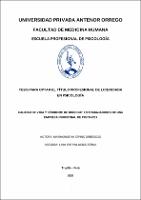Mostrar el registro sencillo del ítem
Calidad de vida y síndrome de Boreout en trabajadores de una empresa industrial de Pisco - 2019
| dc.contributor.advisor | Palacios Serna, Lina Iris | |
| dc.contributor.author | Espino Orbegoso, Mariaximena | |
| dc.creator | Espino Orbegoso, Mariaximena | |
| dc.date.accessioned | 2020-08-14T12:15:18Z | |
| dc.date.available | 2020-08-14T12:15:18Z | |
| dc.date.issued | 2020 | |
| dc.identifier.uri | https://hdl.handle.net/20.500.12759/6418 | |
| dc.description.abstract | El presente estudio sustantivo-descriptivo, con diseño correlacional, tuvo como objetivo principal, determinar la relación entre la calidad de vida y síndrome de boreout en trabajadores de una empresa industrial de Pisco-2019. La población estuvo compuesta por 853 trabajadores de diversas áreas, entre hombres y mujeres pertenecientes a la adultez; la muestra estuvo conformada por 377 participantes, quienes accedieron a participar voluntariamente de la investigación; se emplearon dos instrumentos, el primero fue el CUESTIONARIO DE CALIDAD DE VIDA, en la versión adaptada por Ventura (2018) y la ESCALA DE BOREOUT creada y adaptada por Azabache (2016). Los resultados permiten evidenciar que existe una relación directa, estadísticamente significativa y de magnitud moderada (p<.05) entre la Calidad de Vida con el Síndrome de Bureout [rs=.16 (.06 - .26); p=.002]. En relación a los niveles se aprecia una tendencia media en ambas variables, de un 51% y 64% respectivamente | es_PE |
| dc.description.abstract | The present substantive-descriptive study, with correlational design, had as main objective, to determine the relationship between the quality of life and boreout syndrome in workers of an industrial company of Pisco-2019. The population was made up of 853 workers from different areas, between men and women belonging to adulthood; the sample was made up of 377 participants, who agreed to voluntarily participate in the research. Two instruments were used, the first one was the QUALITY OF LIFE QUESTIONNAIRE, in the version adapted by Ventura (2018) and THE BOREOUT SCALE created and adapted by Azabache (2016). The results show that there is a direct, statistically significant and moderate magnitude relationship (p <.05) between Quality of Life and Bureout Syndrome [rs = .16 (.06 - .26); p = .002]. In relation to the levels, there is an average trend in both variables, of 51% and 64% respectively. | en_US |
| dc.description.uri | Tesis | es_PE |
| dc.format | application/pdf | es_PE |
| dc.language.iso | spa | es_PE |
| dc.publisher | Universidad Privada Antenor Orrego - UPAO | es_PE |
| dc.relation.ispartofseries | T_PSI_208 | |
| dc.rights | info:eu-repo/semantics/openAccess | es_PE |
| dc.source | Universidad Privada Antenor Orrego | es_PE |
| dc.source | Repositorio Institucional - UPAO | es_PE |
| dc.subject | Síndrome de Boreout | es_PE |
| dc.subject | Calidad de vida | es_PE |
| dc.title | Calidad de vida y síndrome de Boreout en trabajadores de una empresa industrial de Pisco - 2019 | es_PE |
| dc.type | info:eu-repo/semantics/bachelorThesis | es_PE |
| thesis.degree.level | Título Profesional | es_PE |
| thesis.degree.grantor | Universidad Privada Antenor Orrego. Facultad de Medicina Humana | es_PE |
| thesis.degree.name | Psicólogo | es_PE |
| thesis.degree.discipline | Psicología | es_PE |
Ficheros en el ítem
Este ítem aparece en la(s) siguiente(s) colección(es)
-
Psicología [436]

